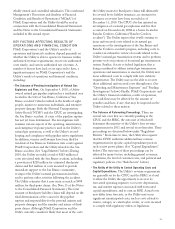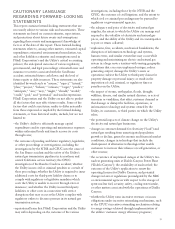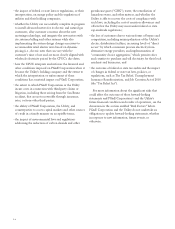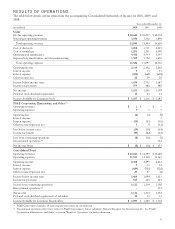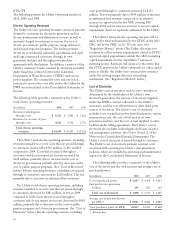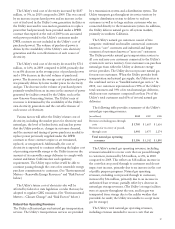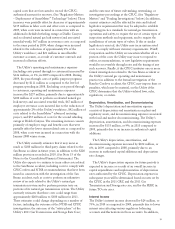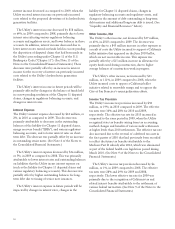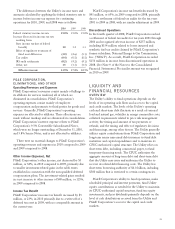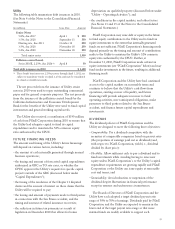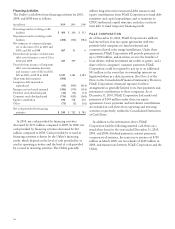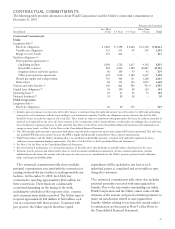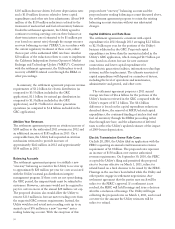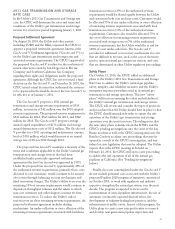PG&E 2010 Annual Report Download - page 25
Download and view the complete annual report
Please find page 25 of the 2010 PG&E annual report below. You can navigate through the pages in the report by either clicking on the pages listed below, or by using the keyword search tool below to find specific information within the annual report.
The differences between the Utility’s income taxes and
amounts calculated by applying the federal statutory rate to
income before income tax expense for continuing
operations for 2010, 2009, and 2008 were as follows:
2010 2009 2008
Federal statutory income tax rate 35.0% 35.0% 35.0%
Increase (decrease) in income tax rate
resulting from:
State income tax (net of federal
benefit) 1.0 1.4 3.3
Effect of regulatory treatment of
fixed asset differences (3.0) (2.6) (3.1)
Tax credits (0.4) (0.5) (0.5)
IRS audit settlements (0.2) (4.2) (4.1)
Other, net 1.5 (1.3) (1.7)
Effective tax rate 33.9% 27.8% 28.9%
PG&E CORPORATION,
ELIMINATIONS, AND OTHER
Operating Revenues and Expenses
PG&E Corporation’s revenues consist mainly of billings to
its affiliates for services rendered, all of which are
eliminated in consolidation. PG&E Corporation’s
operating expenses consist mainly of employee
compensation and payments to third parties for goods and
services. Generally, PG&E Corporation’s operating
expenses are allocated to affiliates. These allocations are
made without mark-up and are eliminated in consolidation.
PG&E Corporation’s interest expense relates to PG&E
Corporation’s 9.5% Convertible Subordinated Notes,
which were no longer outstanding at December 31, 2010,
and 5.8% Senior Notes, and is not allocated to affiliates.
There were no material changes to PG&E Corporation’s
operating revenues and expenses in 2010 compared to 2009
and 2009 compared to 2008.
OtherIncome (Expense), Net
PG&E Corporation’s other income, net decreased by $3
million, or 38%, in 2010 compared to 2009, primarily due
to smaller investment-related gains in the rabbi trusts
established in connection with the non-qualified deferred
compensation plans. The investment-related gains resulted
in a net increase to other income of $40 million, or 125%,
in 2009 compared to 2008.
Income Tax Benefit
PG&E Corporation’s income tax benefit increased by $5
million, or 23%, in 2010 primarily due to a write-off of a
deferred tax asset in 2009, with no comparable amount in
the current year.
PG&E Corporation’s income tax benefit decreased by
$41 million, or 65%, in 2009 compared to 2008, primarily
due to a settlement of federal tax audits for the tax years
2001 to 2004 in 2008, with no similar adjustment in 2009.
Discontinued Operations
In the fourth quarter of 2008, PG&E Corporation reached
a settlement of federal tax audits for tax years 2001 through
2004 and recognized after-tax income of $257 million,
including $154 million related to losses incurred and
synthetic fuel tax credits claimed by PG&E Corporation’s
former subsidiary, National Energy & Gas Transmission,
Inc. (“NEGT”). As a result, PG&E Corporation recorded
$154 million in income from discontinued operations in
2008. (See Note 9 of the Notes to the Consolidated
Financial Statements.) No similar amount was recognized
in 2010 or 2009.
LIQUIDITY AND
FINANCIAL RESOURCES
OVERVIEW
The Utility’s ability to fund operations depends on the
levels of its operating cash flows and access to the capital
and credit markets. The levels of the Utility’s operating
cash and short-term debt fluctuate as a result of seasonal
load and natural gas, volatility in energy commodity costs,
collateral requirements related to price risk management
activity, the timing and amount of tax payments or
refunds, and the timing and effect of regulatory decisions
and financings, among other factors. The Utility generally
utilizes equity contributions from PG&E Corporation and
long-term senior unsecured debt issuances to fund debt
maturities and capital expenditures and to maintain its
CPUC-authorized capital structure. The Utility relies on
short-term debt, including commercial paper, to fund
temporary financing needs. The CPUC authorizes the
aggregate amount of long-term debt and short-term debt
that the Utility may issue and authorizes the Utility to
recover its related debt financing costs. The Utility has
short-term borrowing authority of $4.0 billion, including
$500 million that is restricted to certain contingencies.
PG&E Corporation’s ability to fund operations, make
scheduled principal and interest payments, fund Utility
equity contributions as needed for the Utility to maintain
its CPUC-authorized capital structure, fund tax equity
investments, and pay dividends primarily depends on the
level of cash distributions received from the Utility and
PG&E Corporation’s access to the capital and credit
markets.
21


